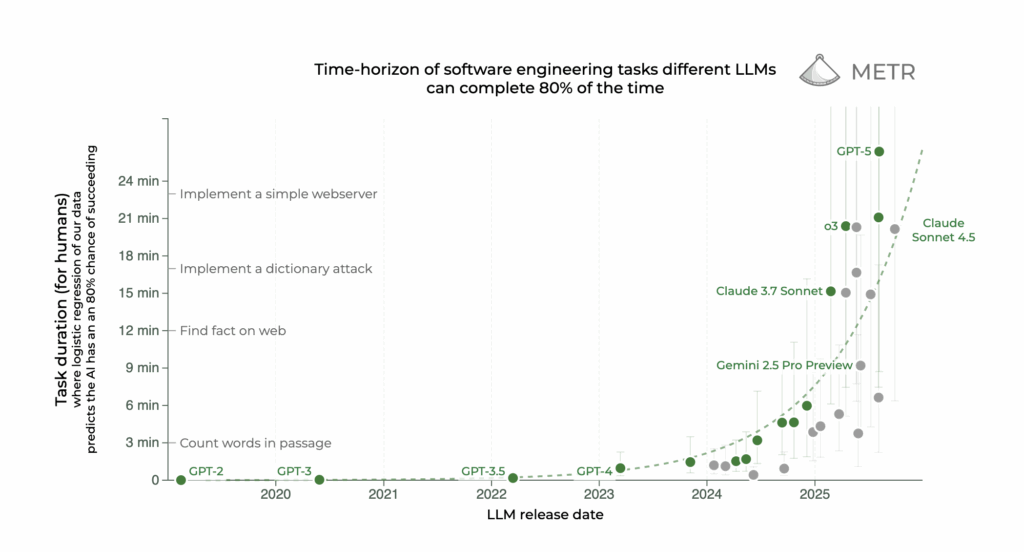Just a few months ago, it felt like the prevailing narrative was the incredible and unstoppable rise of AI. Reporters left and right were profiling the site AI2027, a techno-optimist forecast of AI’s trajectory over the next 2–3 years. But since then, I’ve noticed a rising number of more pessimistic stories — ones that talk about social and interpersonal risks, financial peril, and the idea that the development of AI technology is slowing. While the first two concerns are worth considering, today we’ll focus on the idea that AI development is slowing.
For those of you with kids, you’ll likely remember the days when they were babies, and each day seemed to bring some new incredible skill. Sitting up, crawling, talking, walking, and learning to open every cabinet door in the kitchen. It was hard to miss the almost daily changes. Family members would visit and note the changes, and as a parent, you would readily agree. The child in question inevitably had doubled in size in less than a year. But as they grew, development seemed to slow, making visiting family members the only ones to be amazed by a child’s growth. Their absence allowed them to see the remarkable change. “Wow,” they would say, “little Johnny has truly gotten big.”
I see the same with AI development today.
Models introduced last year and even earlier this year had a feeling of novelty, of magic. For many of us (yours truly included), it was an experience to see that AI tools had personality and possible utility for the first time. The examples: help me solve a problem, answer a question, clean up some writing, write a piece of code, etc. It was like watching an infant grow into someone who could talk.
Perhaps more akin to elementary-age children, the pace of change for AI tools doesn’t feel as fast for many folks. The WSJ (and others) are publishing articles like “AI’s Big Leaps Are Slowing—That Could Be a Good Thing” that frame the AI story as a slowdown. But those headlines usually track product launches, not capability evolution. But I don’t see much evidence that product launches are slowing (I can count scores of product launches just in the past few months). I see it more along the lines that people came to believe AGI would mature more quickly than even the industry leaders claimed.
It’s like Bill Gates’ maxim: “We always overestimate the change that will occur in the next two years and underestimate the change that will occur in the next ten.”
The Nielsen Norman Group has tracked this shift in users. As conversational AI becomes the baseline, search behaviors evolve. Queries are less about “find me a link” and more about iterating with an AI assistant. In their follow-up on user perceptions, people described new agent features as “expected” rather than “wow” (NNG, 2025). The bar has moved. Our expectations have flattened because most people don’t see those agentic and long-horizon use gains. They see new AI features, feel underwhelmed, and assume the hype was overblown.
Earlier this year, METR published research showing that models are increasingly capable of long-horizon tasks, executing sequences of operations with minimal oversight. They have since updated their report with data inclusive of more recent models.

Meanwhile, on the macroeconomic stage, activity hasn’t slowed. AI investment is still surging, with economists crediting the technology for meaningful boosts to growth. There are mixed reports about adoptions: Apollo Academy reports a cooling in AI adoption rates among large corporations—even as internal development ramps up. But AI coding tool installation continues to rise. Tracking the number of installs of the top 4 AI coding tools, you’ll find a nearly 20% increase in daily installations over the past 30 days.
Back to AI 2027, the predictions about agentic AI in late 2027 seem to be more or less on pace, with perhaps a month or so of deviation. The risk of all of this is to mistake familiarity for maturity. The awe has worn off, so it’s easy to assume the growth has too. But if you look at what METR’s testing shows, how users are integrating AI without fanfare, how developers are integrating AI tools into their work, and how capital is still flowing—the picture is clear. Progress remains swift.
⸻
AI development isn’t truly slowing—it’s maturing. As the initial novelty wears off, real advances continue beneath the surface, driven by capability gains, steady investment, and evolving user behavior.
Leave a Reply